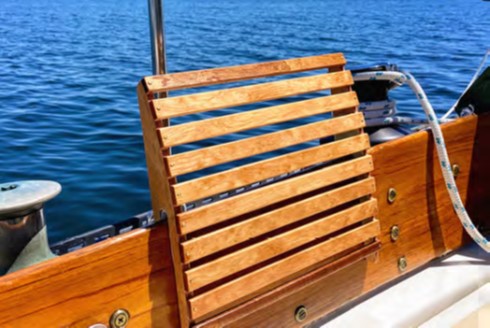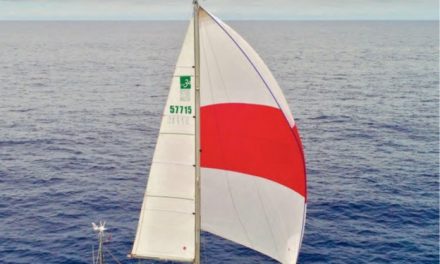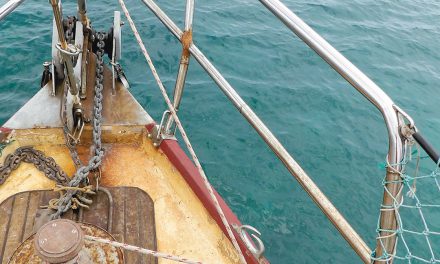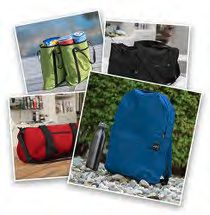Extensions make older-style cockpit coamings far more comfy to lean against.
Issue 141: Nov/Dec 2021
Kicking back and relaxing in the cockpit of one’s sailboat, especially if it is well-designed, constitutes one of the many joys of boating. Of course, cockpit designs–like the boats they belong to–vary widely. Some are better suited for racing while others, cruising. Either way, finding a comfy seat for a sundowner or twilit dinner is imperative.
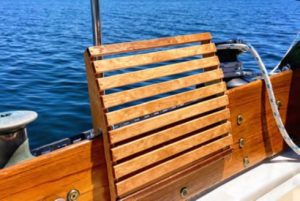
One of the coaming board extensions installed and ready for use.
Our 56-year-old Allied Seabreeze, Secret Water, is a 35-foot cruiser that’s old enough to have traditional cockpit coaming boards. These were a standard feature on many wooden boats, and when carried over into the cockpits of early fiberglass boats, they were a ubiquitous feature aboard many designs by Bristol, Pearson, and Cape Dory.
In general, the freeboard of yachts was lower in the early days of fiberglass, and sheer lines were graceful. Over time, as freeboard got higher, cockpits became deeper. This allowed for higher coamings.
If your coamings are low, as they are on Secret Water, they may not provide quite enough back support. It’s simple to make extensions that slip over your boat’s cockpit coaming boards—picture the back of an Adirondack chair—that render them much more comfortable.
Designs for making your own cockpit coaming board extensions have been around for decades; I can’t take credit for the idea. Still, even being aware of them and fully intending to make some, it took me nearly 20 years to see the idea through to fruition.
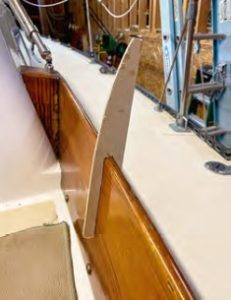
The first step was to cut seat uprights out of okoume marine plywood. When fitting the uprights to the coaming boards, Art intentionally made the slots oversized to accommodate strips of leather he added later to protect the coaming boards’ varnish.
The first thing I did was make vertical supports to hold the extensions upright. I made these from okoume marine plywood, cutting slots into them so that I could slip them over the coaming boards. I made these slots bigger than they needed to be, because I knew I would go back and glue strips of leather into them to protect the varnish on the coamings.
Next, using a bit of MAS epoxy resin left over from a kayak project, I bonded rectangles of G-10 fiberglass epoxy laminate sheet to the okoume uprights, and cut matching slots in them. When the coaming board extensions were finished, the G-10 would be hidden from view while strengthening the extensions.
Once this step was completed, I made a simple jig to keep the uprights parallel while I attached a combination of Douglas fir and African mahogany slats (more leftovers) using MAS epoxy and brass escutcheon pins. Though they really just hold things in place while the epoxy cures, the pins do give the extensions a traditional appearance. It’s important to pre-drill the holes; failure to do so can split the slat or the upright it’s being fastened to.
In general, whenever I add something to my boat, I always consider how best to store the item. In this case, I wanted the extensions to be handy, fearing they would get little use if they weren’t. To reduce their footprint aboard, I made one of the two extensions slightly smaller than the other so they could slide inside each other a bit like the mating of shopping carts. A simple hook made of scrap okoume, mounted just inside the cockpit sail locker, provides an easily accessible place to hang them for storage.
Now, as the shadows grow long aboard Secret Water, her cockpit is a much more comfortable place to unwind and take in the beauty of our surroundings.
Art Hall and his wife, Sandy, sail their 1975 Allied Seabreeze 35, Secret Water, in and around the waters of Penobscot Bay, Maine. Occasionally they’ll push farther Down East in search of less-crowded anchorages. Art enjoys the challenge of keeping a good old boat going strong from season to season, decade to decade, and making it even more comfortable along the way.
Thank you to Sailrite Enterprises, Inc., for providing free access to back issues of Good Old Boat through intellectual property rights. Sailrite.com

